Download the PDF of the report.
Executive Summary
A relentless series of destructive extreme weather events last year has staggered farmers and taken a toll on state governments around the country. From Hurricanes Harvey and Irma hitting parts of the south to droughts and wildfires in the Midwest to heatwaves in the West, farmers and rural communities are struggling to recover.
It is difficult to attribute any single weather event to climate change, but the rise in the number of extreme weather events, and the increase in their severity, are consistent with what the science tells us to expect from climate change. This year is on track to be one of the costliest in terms of weather-related damage in American history, consistent with the long-term upward trend in the number of extreme weather events costing more than one billion dollars, according to the National Oceanic and Atmosphere Administration (NOAA).1
State governments are finding themselves on the front lines of responding to climate change, including the immediate and long-term effects on agriculture. These climate-related effects drain state government budgets and cause enormous financial and emotional harm to farmers and rural communities.
The severity of climate-related impacts will depend largely on how our farming systems respond to changes in local conditions. Climate adaptation plans, when implemented, can lower costs for local governments and lower risks for farmers and agriculture-related businesses—and potentially create new markets for businesses and farmers. The urgency to act on climate change is leading governments and businesses all over the world to develop climate adaptation plans.
At the international level, the Intergovernmental Panel on Climate Change (IPCC) recommends that climate adaptation planning be place- and context-specific, with no single approach for reducing risks across all settings. In the U.S., the National Caucus of Environmental Legislators (NCEL) has been a leader in promoting state-based climate adaptation, because no two states or communities will experience climate change in exactly the same way.
Unfortunately, too many states don’t have climate adaptation plans and those that do often do not include agriculture. Currently, only 18 states have climate adaptation plans that include agriculture. Of those 18, recommendations on agriculture are too often general and aspirational, disconnected from the policies or resources required to follow-up on and implement them. There are also some exceptions and examples of truly innovative thinking at the state-level that other states can learn from.
In this paper, we analyze how state climate adaptation plans treat agriculture and food systems, identify challenges and best practices and lift-up innovative approaches for the future. To conduct the analysis, we cataloged every state with a climate adaptation plan that makes concrete recommendations for agricultural adaptation. We created a list of every agriculture-related policy proposal in each state plan and sorted those strategies into ten categories based on our best interpretation of their goals. We pulled from eight strategies identified by the USDA in the 2016 report “Adaptation Resources for Agriculture,”2 and added two additional categories we identified as important, covering financial support and technical assistance.
Key Findings
A few important trends stand out in state climate adaptation plans.
- Few states are considering ambitious changes to their agricultural systems, such as changing crop types to fit the altered climate or using new approaches to animal production.
- Locally focused adaptation strategies with less daunting scopes, such as those focused on soil and water quality, have gained traction.
- Strategies designed to support farmers with technical and financial support for climate adaptation are well-represented.
- Very little attention is given to biodiversity, how to “manage farms and fields as part of a larger landscape,” a potentially powerful tool in the face of climate change.
- Investing in agriculture-related infrastructure as part of climate adaptation is similarly under-represented.
Challenges Moving Forward
States have an opportunity to lead on climate policy and particularly on adaptation. States can proactively engage their citizens in climate resilience strategies for their communities and economies and work with farmers to adapt agricultural systems for the future. This analysis of state climate adaptation plans revealed several key challenges for states:
- There is an implementation hurdle after adaptation plans are written. Adaptation plans can transition directly from the writing process to the shelf if not supported by state agency action and policy.
- Adequate financial resources and institutional support mechanisms are needed. To ensure a successful and just transition to climate resilient agricultural systems, resources and support must be available. Farmers often operate on razor thin profit margins, making independent adaptation action difficult.
- States are not ready to include strategies that involve the significant altering of agricultural systems to new climate conditions. Careful thinking and planning on these bigger issues will be necessary for future climate adaptation plans.
- Political resistance to climate action must be overcome. States should increase engagement with farmers and rural communities as partners in adaptation planning now. Taking the time to ensure farmers are engaged early on and have input in the development of climate adaptation plans is essential to a successful plan.
- States that lack adaptation plans entirely need to begin preparing. As the costs of inaction on climate adaption rise, states will be forced to start planning.
The weather events of the last year highlight how states that continue to ignore climate adaptation will end up paying the price. Farmers in every state are dealing with a variety of climate-related changes, some immediate and others long-term. States can learn from past experience, and each other, by engaging with farmers and rural communities to build climate resilience into future planning.
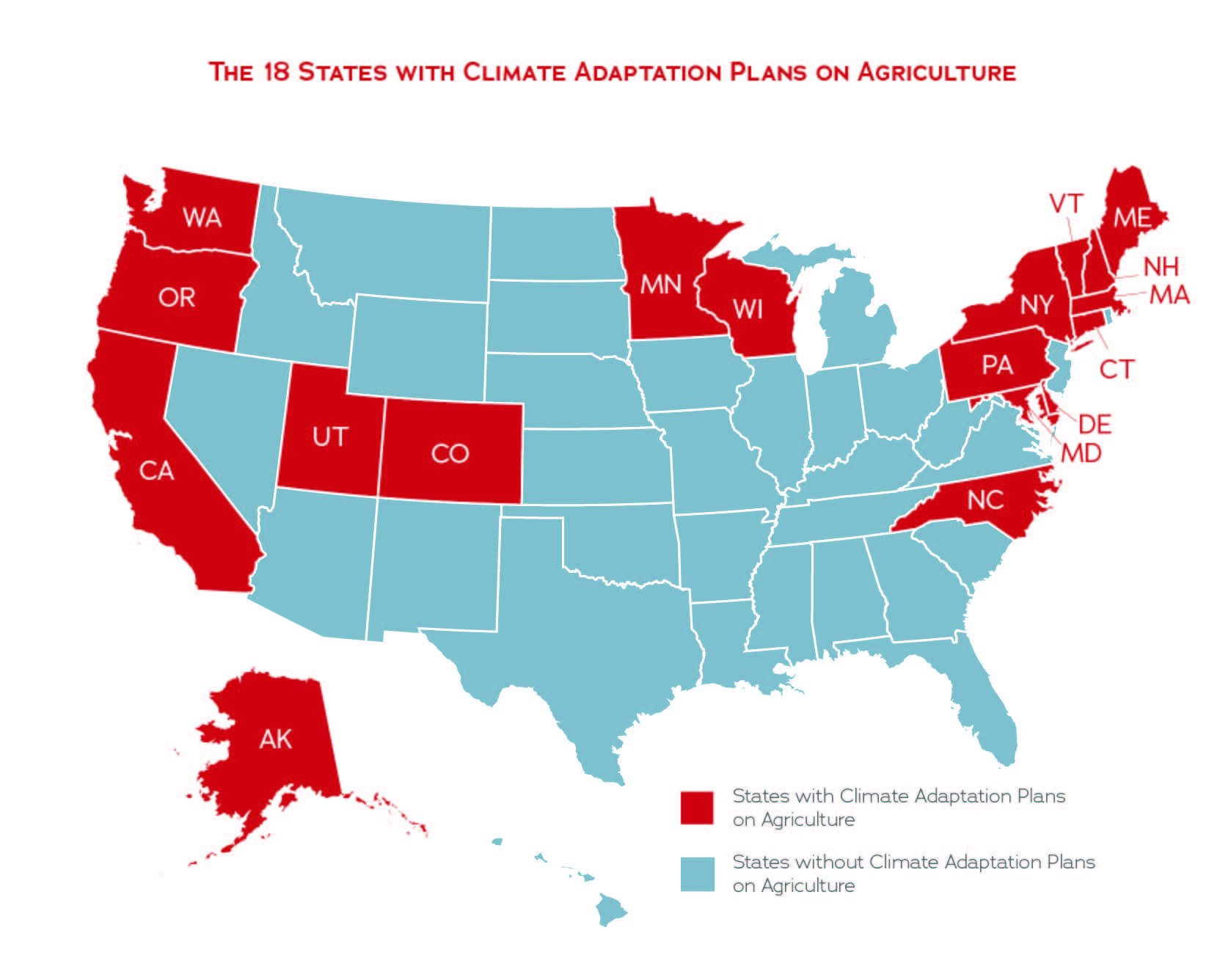
Part 1: Introduction: Agriculture’s Climate Risk
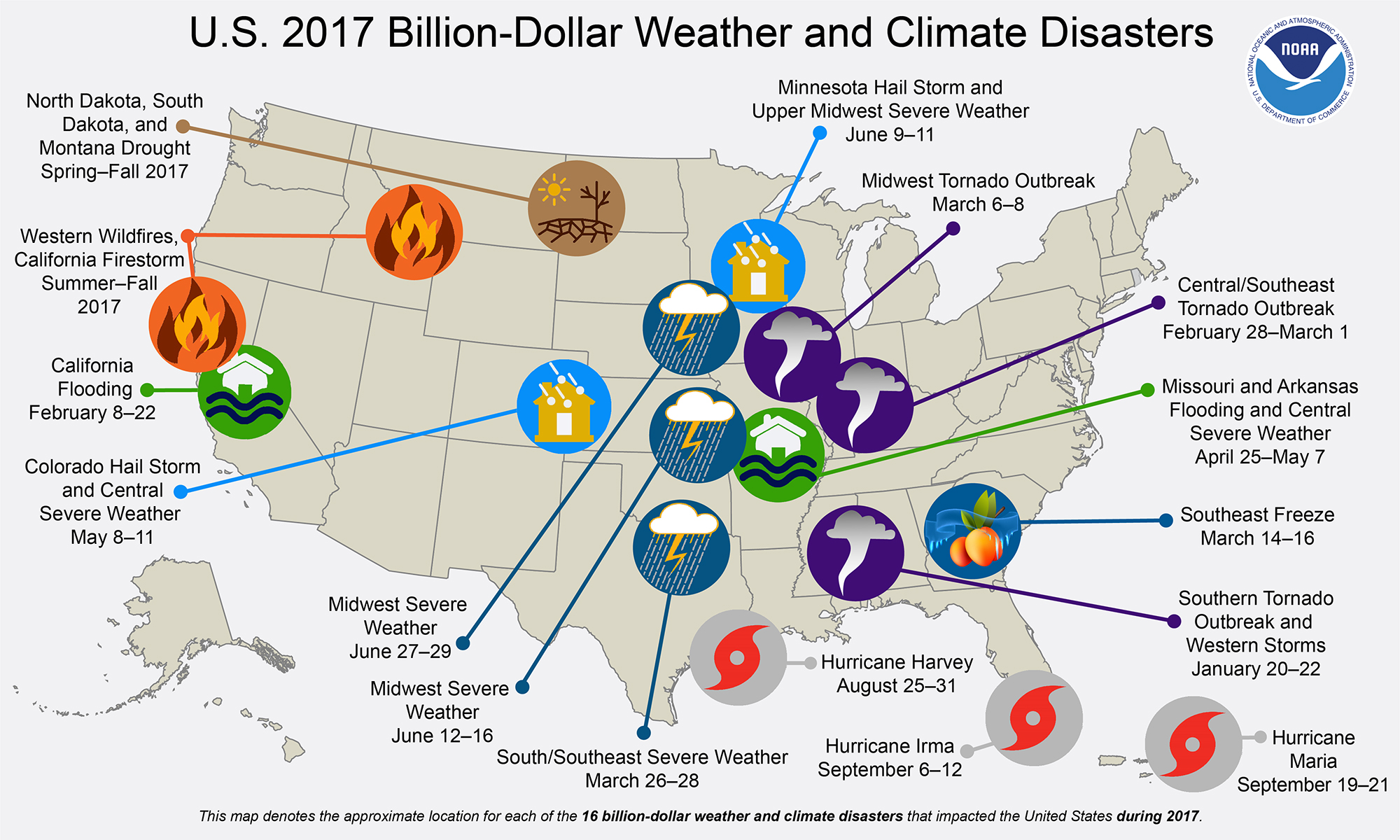
A relentless series of destructive, extreme weather events this year has staggered farmers and taken a toll on state governments around the country:
- Hurricane Harvey caused an estimated $200 million in agricultural losses when it left Texas cotton hanging from trees, cattle huddled on high ground, and much of the state’s hay crop underwater.3,4
- Hurricane Irma’s agriculture losses are an estimated $2.5 billion, including wiping out about half of Florida’s citrus crop.5,6
- A severe drought followed by extensive wildfires in the Dakotas and Montana forced many farmers to sell off cattle and resulted in extensive crop losses in the country’s biggest wheat region.7,8,9
- Severe heat in California’s avocado-raising regions last year caused a shortfall this year,10 while a June heatwave in the state resulted in an estimated 4,000-6,000 dead cows.11
- Wildfires swept through Kansas, Oklahoma, Colorado and Texas in March, burning up an estimated 660,000 acres of pasture,12 and killing an estimated 20,000 pigs and cattle.13
- Feedyards in Kansas, Colorado, Texas and Nebraska were hit with a blizzard in April that caused thousands of cattle deaths.14
- Spring floods damaged an estimated 940,000 acres of crops in Arkansas.15
It is difficult to attribute any single weather event to climate change, but the rise in the number of extreme weather events, and an increase in their severity, are consistent with what the science tells us about climate change. According to the U.S. National Climate Assessment,16 climate-related disruptions have increased steadily over the last 40 years and are expected to rise further in the future. This year is on track to be one of the costliest in terms of weather-related damage, consistent with the long-term upward trend in the number of extreme weather events costing more than one billion dollars, according to NOAA.17 (See "U.S. Billion-Weather and Climate Disasters" graphic on the previous page.)
State governments are finding themselves on the front lines of responding to these weather disasters, including those that affect farmers. These disasters can drain state government budgets, but as importantly cause enormous financial and emotional harm to farmers and rural communities. When a farm faces drought, wildfires or a flood, it is not just their livelihood that is affected; it is often also their home, land, animals and their community. (See a snapshot of the 2017 crop loss insurance claims in the USDA maps on the following page.)
Aside from an increase in disasters, climate change is already affecting agriculture. In the Midwest and Northeastern states for example, temperatures have already risen across all seasons, growing seasons have become longer and there have been more extreme precipitation events in frequency and severity, according to the U.S. Department of Agriculture.18
An October 2016 USDA report on climate adaptation identified these major risks to agriculture based on future climate trends:19
- Extreme precipitation increases risk of damage to crops, soils and infrastructure;
- Increase in flood damage to agricultural land and production;
- Severe wind and storm hazards could affect crops, land and infrastructure;
- Warmer temperatures increase the potential for soil moisture stress and drought;
- Competition from weeds and invasive plant species may increase;
- Populations of damaging insects may increase;
- The risk of plant pathogens may rise; and
- The risk of pressure from pathogens and parasites of livestock may rise.
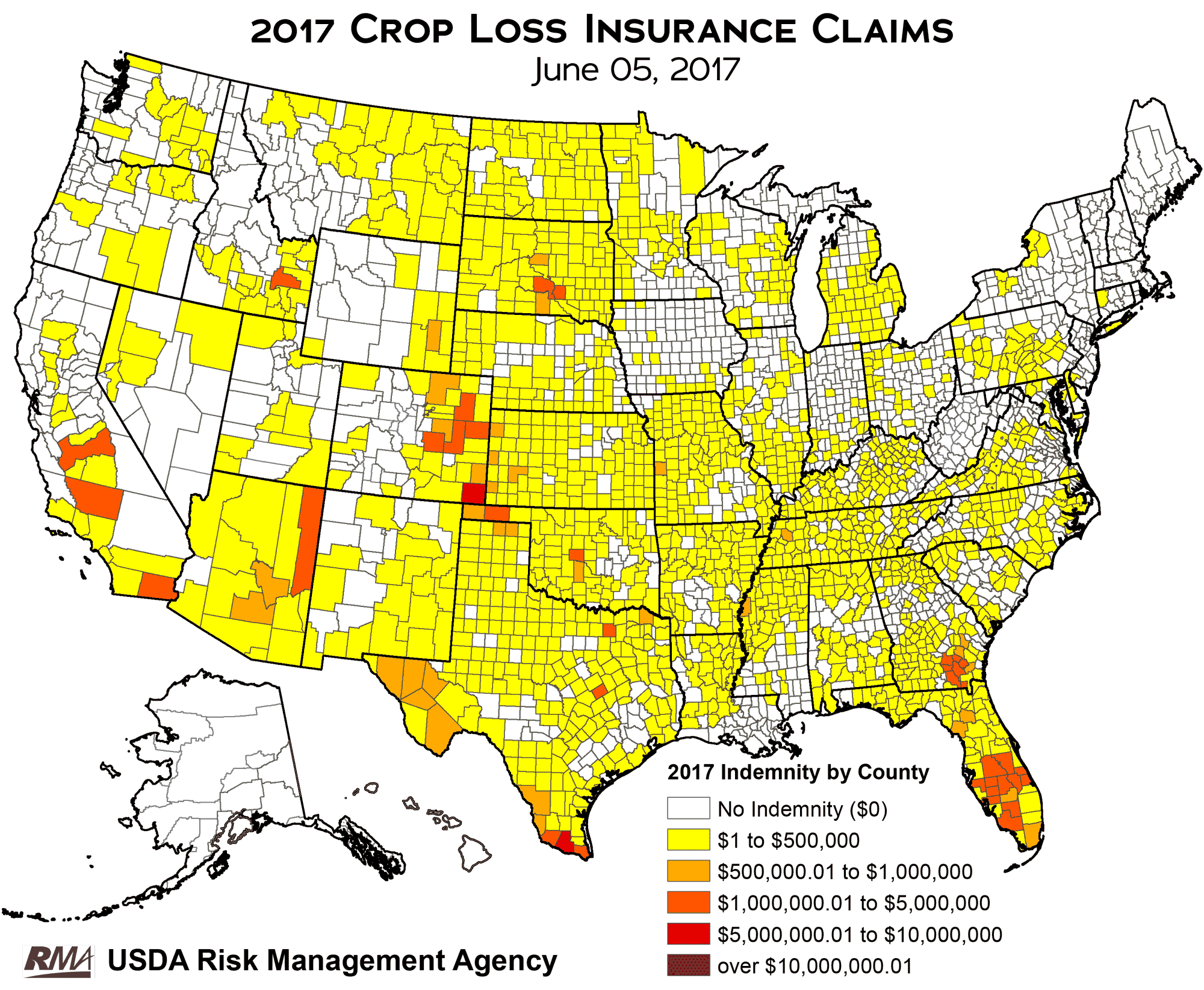
These climate-related risks are in addition to other challenges farmers face, including volatile markets that often pay below-cost-of-production prices and increased corporate concentration that is leading to diminished competition in most agriculture sectors. The severity of climate-related impacts will depend largely on how our farming systems respond to changes in local conditions. These responses, whether short-term or long-term, are climate adaptation strategies, and, like most strategies, they are stronger if part of a larger, coordinated plan. Climate adaptation strategies for agriculture could include adjusting planting patterns, using more resilient crops, or changing livestock management. Shifts in weather patterns, the timing of pollination and precipitation will require shifts in agricultural production—with different crops being affected differently.
While innovative farmers may adapt in the short-term, over the long-term, more transformational strategies focused on resilience in agricultural systems will be needed. Those strategies will have to be supported by a new, broad-reaching policy framework that includes farm financing and credit, research and technical assistance, insurance and conservation programs and other rural development initiatives. Part of withstanding weather disruptions is the ability to withstand them financially. Climate risk will be added to the other risks, particularly economic, that farmers already face.
Part 2: Why Climate Adaptation Plans Matter
At a very basic level, climate adaptation plans help prepare for the future. Many researchers view agricultural climate adaptation as a series of actions that begin by addressing short-term, immediate needs and build toward more transformational changes over time. Activities can fall into two areas: managing production within the existing system and managing the changes that are coming, including changes to the system. Both strategies can exist simultaneously. Climate adaptation plans should help lower costs for local governments, lower risks for farmers and agricultural-related businesses and possibly create new markets for businesses and farmers. These types of plans can be done at the community, regional, state or national level. And they can be done by individual businesses or within sectors.
The severity of climate change is leading governments and businesses all over the world to develop climate adaptation plans. Much of the business and investment community is taking proactive steps to assess their climate risk, such as how changes in the climate affect their future business and investments. The nonprofit organization CERES is actively working with investors and companies to analyze and rate food companies’ risk associated with sustainability, including climate risk.20 National business leaders Michael Bloomberg, Henry Paulson and Tom Steyer co-chaired a committee that included Cargill Chairman Gregory Page on the Economic Risks of Climate Change to the U.S. Their 2014 report, Risky Business, concluded that without adaptation, many Midwestern and Southern states could see a decline in crop yields of more than 10 percent over the next 5 to 25 years.21 The report also emphasized that each region of the country is different, with its own culture and economy, and as such, “we must take a regional approach to fully understand our climate risk.”
According to the Intergovernmental Panel on Climate Change (IPCC), adaptation plans are becoming more common among governments. Given that the effects of climate change are complex and difficult to predict, governments have partnered with universities, businesses and stakeholders to share information and resources, identify gaps and develop plans across sectors. The United Nations Food and Agriculture Organization has developed indicators for governments to assess their climate adaptation strategies for agriculture.22
The IPCC also makes clear that climate adaptation planning is place and context specific, with no single approach for reducing risks across all settings. However, the IPCC has identified some principles for effective climate adaptation:23
- Planning and adaptation can be enhanced through complementary actions across levels, from individuals to governments;
- A first step is to reduce vulnerability and exposure, identifying actions with co-benefits;
- Recognition of diverse interests, circumstances, social-cultural contexts and expectations benefit the decision-making process;
- Poor planning, overemphasizing short-term outcomes, or failing to sufficiently anticipate consequences can result in poor adaptation; and
- Significant co-benefits, synergies and trade-offs, exist between mitigation (greenhouse gas reduction) and adaptation.
Consistent with this call for regionally focused strategies, states are uniquely positioned to act on climate, particularly in the case of agriculture-related climate adaptation. Farming is literally dependent on the local and regional geography, and as a result, policy and strategy frameworks for climate adaptation must be built from the ground up.
The NCEL has been a leader in promoting state-based climate adaptation. In a 2014 report, NCEL wrote that states are the appropriate forum for climate adaptation because no two states or communities will experience climate change in exactly the same way: “States no longer have a choice to adapt to climate change, as these conditions will continue and intensify for decades even if aggressive greenhouse gas mitigation is successful. ... Adaptation must be timely, swift and effective.”
Many farmers are already taking steps to adapt to a changing climate. Many of these strategies have long been part of sustainable practices, and are now being reintegrated and in some cases reinvented in our current context. A growing number of farmers are focusing on building soil health so that it better holds water, adjusting their planting patterns, managing grazing, using cover crops24 and practicing no-till farming.25 Recent research has found that cover crops or perennial crops can help create spongy soil that better retains water.26 Other adaption strategies include reintroducing an integrated crop-livestock system.27
Many climate adaptation strategies have multiple benefits, such as soil health improvement, water quality protection, wildlife habitat management or greenhouse gas mitigation. For example, the use of cover crops can help increase carbon sequestration, while strengthening adaptation. The use of tree cover for livestock can also help sequester carbon.
Additionally, climate adaptation plans at the community and city level in the U.S. are gaining traction. The National Adaptation Forum hosts a series of forums around the country on best practices for climate adaption planning.28 IATP and the Jefferson Center have pioneered a Rural Climate Dialogue model for community-level engagement on climate and adaption planning.29
Legislation and policy to support greater agricultural resilience to climate change is critical. While small-in-number, a handful of states, including Hawaii, Maryland, Massachusetts, New York and Vermont, have introduced bills to support farming practices that build soil health.30 California has a Healthy Soils Program that incentivizes practices that sequester carbon and reduce GHG emissions31 and a state heat protection law to protect agricultural workers.32 New York’s budget this year included a study on incentives for farmers to increase soil health and reduce greenhouse gas emissions.33
But a “policy by policy” approach can be disjointed and fail to build upon larger synergies and strategies. Broader climate adaptation plans offer the opportunity for meaningful engagement with farmers and the rural communities where they live. Stakeholder participation in the development of climate adaptation plans is essential. Stakeholders know the landscape and local economy and can assess whether a proposed strategy will work in the community without unintended consequences. Perhaps most importantly, stakeholder engagement is critical because they are the citizens who are most affected and whose help is most essential to ensure implementation.
Unfortunately, too many states don’t have climate adaptation plans. And those that do often do not include agriculture; currently only 18 states have climate adaptation plans that include agriculture. Of those 18, many include only very general recommendations that are disconnected from policy or the resources for state agencies to follow-up on and implement them. There are also some exceptions and examples of truly innovative thinking at the state-level that should be more widely adopted.
In this paper, we analyze how state climate adaptation plans treat agriculture and food systems, identify challenges and best practices, and lift-up innovative approaches for the future.
Part 3: Methodology
To conduct the analysis, we cataloged every state with a climate adaptation plan that makes concrete recommendations for agricultural adaptation (18 states in total). Then, we created a list of every agriculture-related policy proposal in each state plan, and sorted those policies into ten categories based on our best interpretation of their goals. This categorization revealed the type and number of adaptation strategies recommended by individual states and what strategies are most commonly identified among states.
The ten adaptation strategies we used for our analysis are composed of eight strategies identified by the USDA in the 2016 report “Adaptation Resources for Agriculture,”34 as well as two additional categories we identified as important. The eight USDA categories encompass a variety of responses to threats that climate change poses to agriculture. The ninth and tenth categories are our own creation, intended to cover the important adaptation measures of financial and technical assistance. We refer to this set of ten strategies as the USDA+ categories. They are as follows:
A few limitations to this evaluation approach should be noted. First, in cataloguing the state plans, all recommendations within their “agriculture” sections were included. We also included recommendations in other sections that referred to food or agriculture.
Second, it is difficult to compare policy proposals across states as they can differ greatly in scope and specificity. We have partially accounted for this by allowing broad policies to be counted in multiple categories, but there is still uncertainty in how broader policies will be interpreted and implemented. As a result, the quantitative results of this paper should not be understood in overly specific terms. They provide useful insight into which sectors of adaptation the states are pursuing and which they are not, but should not be taken as exact measures for comparing different categories, or for comparing different states. Furthermore, because of climate variation between states, gaps in certain categories will be more significant in some states than in others.
A third challenge is that most of these plans are voluntary, so there is great variation in how they are implemented. The goal of this paper is to analyze how comprehensively each state’s climate adaptation plans address agriculture-related climate adaptation challenges, but the existence of a plan does not mean it will be implemented well.
Fourth, the term “climate adaptation plan” itself is subjective. For example, some states have climate adaptation plans that do not pay significant attention to agriculture, but they may have other agriculture-specific policy papers. In such cases (e.g. Vermont), we used the agricultural adaptation policy paper. In other cases (e.g. Wisconsin), states produced reports that were not technically “climate adaptation plans,” but which evaluated the dangers posed by climate change to the state with suggestions of adaptation polices noted. We counted such reports in lieu of a full climate adaptation plan.
Finally, several states suggest adaptation policies for fisheries management. Because fisheries management is not a part of the USDA categories, and because it only applies to the few states in which fish are a significant aspect of food production, we decided not to include it as its own category. Instead, we added a note crediting each state that included fish related policies.
Part 4: The States: Trends and Findings
A. General trends among the 18 States.
In our analysis of climate adaptation plans, a few important trends stand out.
- Few states are considering ambitious changes to adapt their agricultural systems or lands to new climate conditions.
Strategies to shift farming systems, including new crops, to new climate conditions were rare or non-existent among states. These large-scale, transformative changes will be needed in the long run, but, possibly due to their cost, complexity, and scale, they are absent in most adaptation plans.
- Locally focused adaptation strategies with less daunting scopes have gained traction.
For instance, strategies for preserving soil and water quality, recommendations that offer tangible, short-term benefits to agricultural production and can be implemented by each farm independently, were included in every plan.
- The two strategies designed to support farmers with technical and financial support for climate adaptation are well-represented in state adaptation plans.
Solutions such as institutional and technical support and coordination policies, had the highest average number of recommended strategies per state. Programs related to financial support hold the third highest average number of recommendations per state.
- Very little attention by most states to biodiversity or how to “manage farms and fields as part of a larger landscape.”
The ecosystem benefits provided by preserving native habitats and biodiversity will be a powerful tool in the face of climate change, but they are being largely ignored by states.
- Infrastructure is similarly under represented.
Rural infrastructure overall is already woefully underfunded, and agriculture-specific infrastructure is no exception. Most states had few strategies related to agricultural infrastructure and climate adaptation.
B. Challenges Moving Forward
States have an opportunity to lead on climate policy, and particularly on adaptation. States can proactively engage their citizens and farmers in protecting their communities and economies, and to begin building the agricultural systems of the future. This analysis revealed several key challenges that states should consider:
- There is an implementation barrier after adaptation plans are written.
The Alaska and Wisconsin experiences reveal how quickly an adaptation plan can transition from the writing process to the shelf if not supported by state agency action and policy. California provides an example of a plan that was implemented well and has successfully monitored its progress.
- Adequate financial resources and institutional support mechanisms must be provided to ensure a successful and just transition to climate-resilient agricultural systems.
Farmers often operate on razor thin profit margins, making it difficult for them to independently undertake climate adaptation. Though our analyses found consistent and promising attention to financing strategies, the need for additional support is apparent.
- States are not ready to include strategies that involve the significant altering of agricultural systems to new climate conditions.
These types of longer-term, structural strategies were often not included in state plans. Careful thinking and planning on some of these bigger issues will be necessary for future climate adaptation plans. Possible strategies offered by the USDA include efforts to minimize the impact of climate disturbances, such as: “Seed short-term cover crops to protect and stabilize soils [after extreme weather].” Other policies require more drastic changes, for example in the location of production or the type of crop in production: “Shift agricultural production spatially, matching commodities to areas with better climate conditions or water availability” and “Convert agricultural lands to new commodities based upon altered climatic conditions, such as converting row crops to perennial forage where water availability decreases.”
- Political resistance to climate action must be overcome.
Though this problem goes far beyond the scope of agricultural adaptation, states should increase engagement with farmers and rural communities as partners in adaptation planning now. Farmers and rural communities are often more open to discussions on climate adaptation than mitigation. Taking the time to ensure farmers are engaged early on and have input in the development of climate adaptation plans is essential. Farmers have knowledge that is essential to a successful plan, and they are, after all, experts on implementation.
- States that lack adaptation plans entirely need to begin preparing.
As the costs of inaction on climate adaption rise, states will be forced to start planning. The sooner the better. States in the southeast and Great Plains will be hit hard by rising temperatures, but have the fewest adaptation plans between them.35
As the last year’s weather events highlight, states that ignore climate adaptation will end up paying the price. Farmers in every state are dealing with a variety of climate-related changes, some immediate and others long-term. States should learn from past experience, and each other, by engaging with farmers and rural communities to build climate resilience into future planning. There are some good models and initiatives out there to guide the bold action that is needed.
How states stack up in each of our ten categories
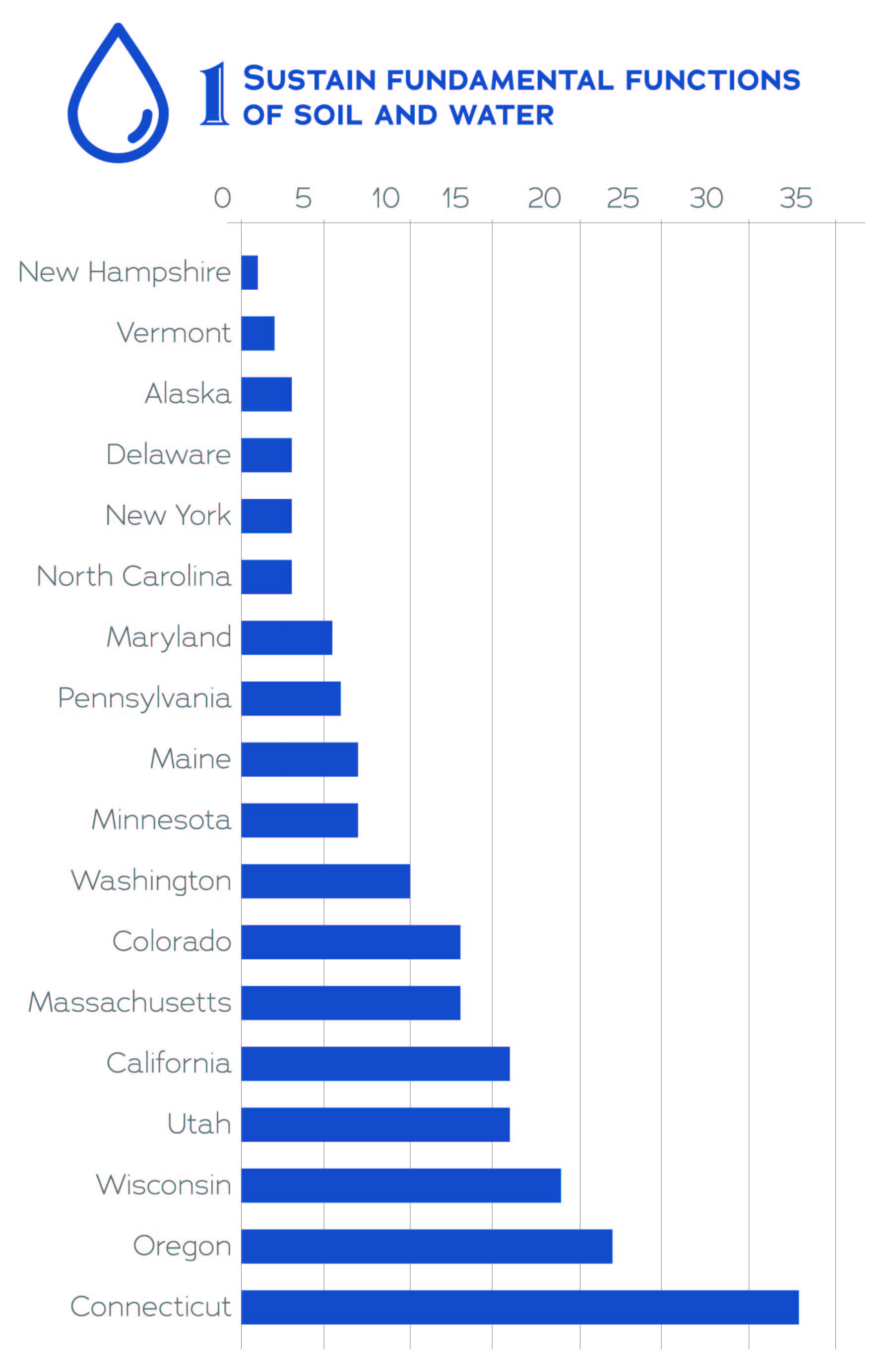
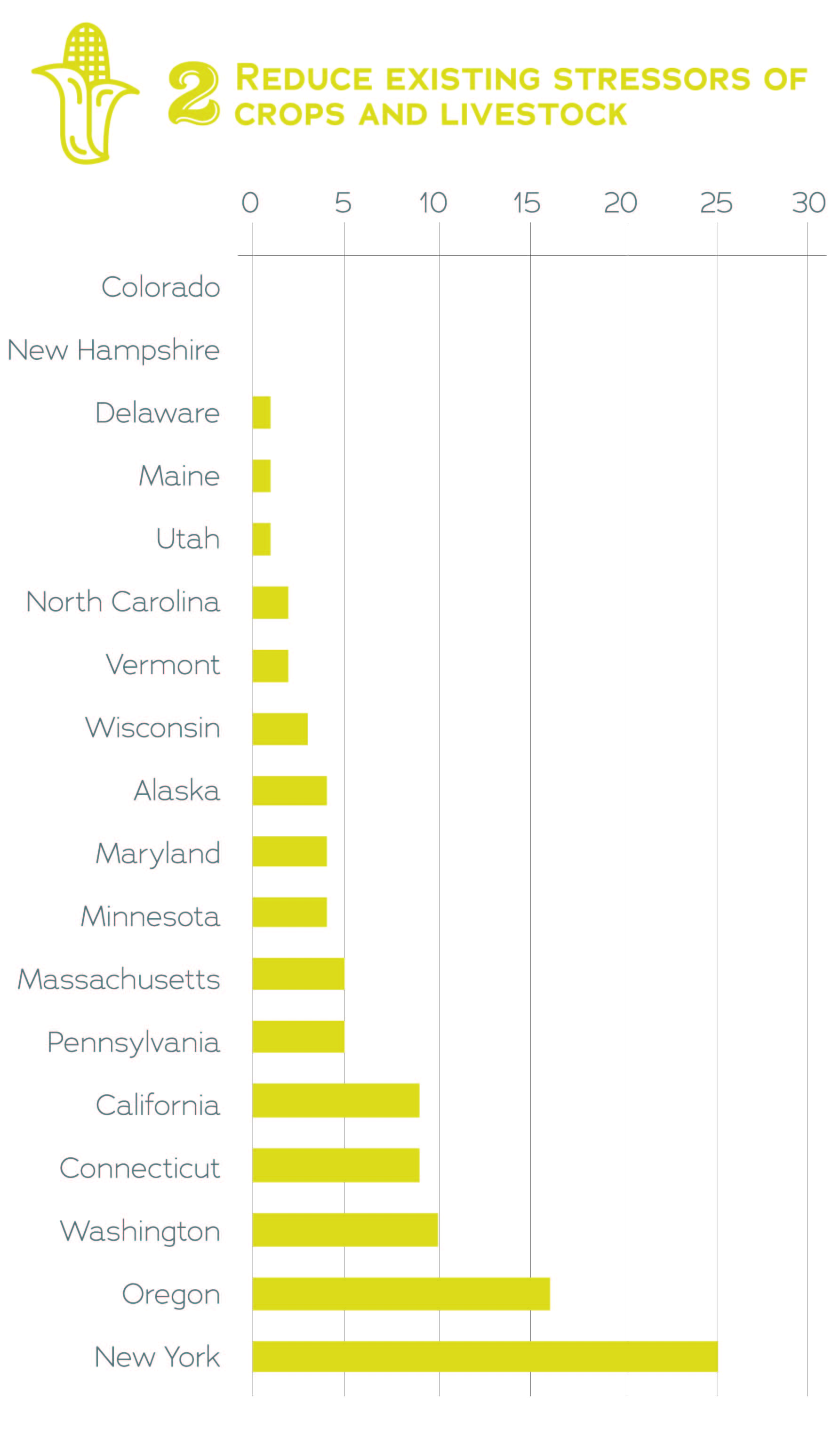
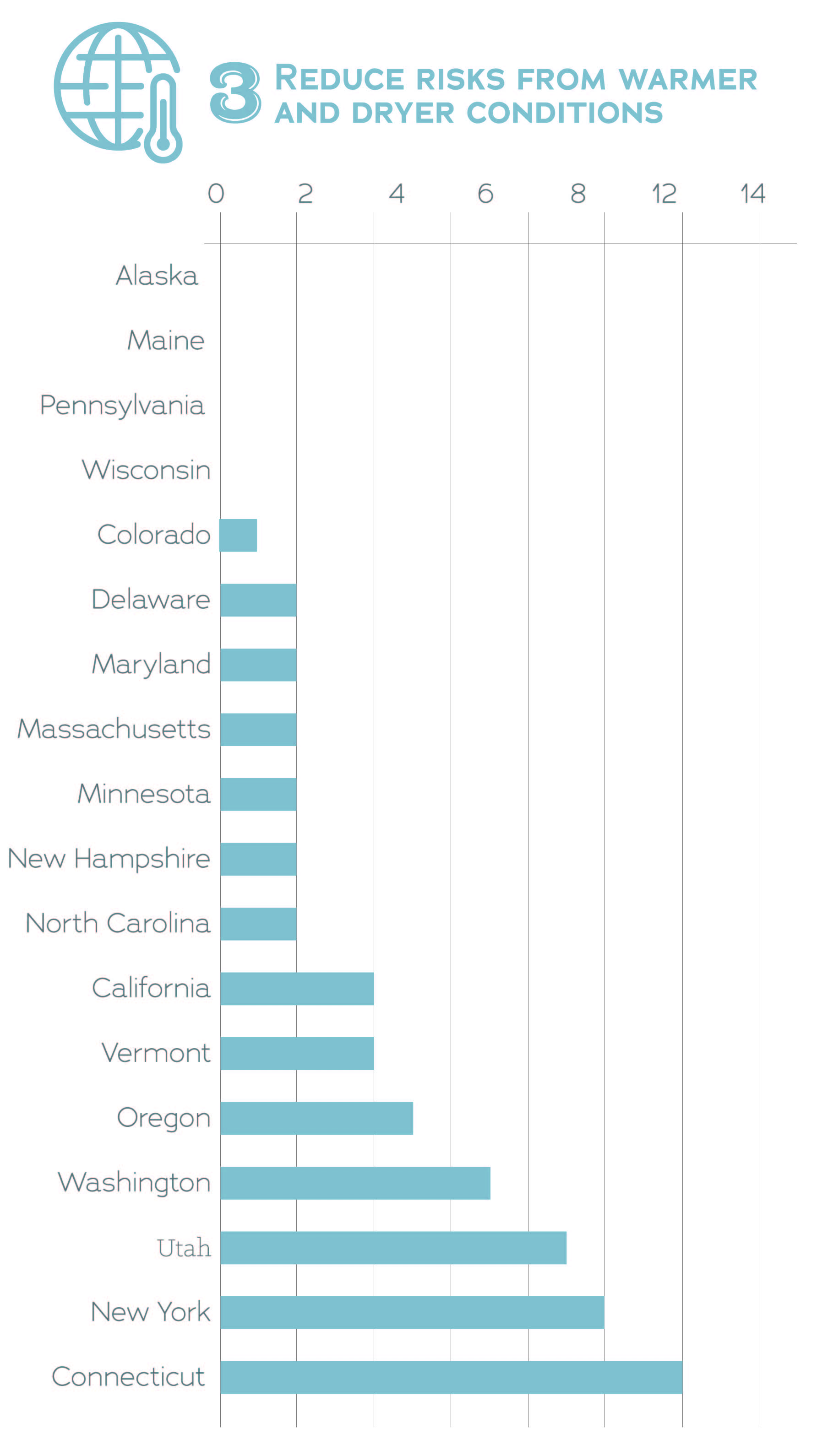
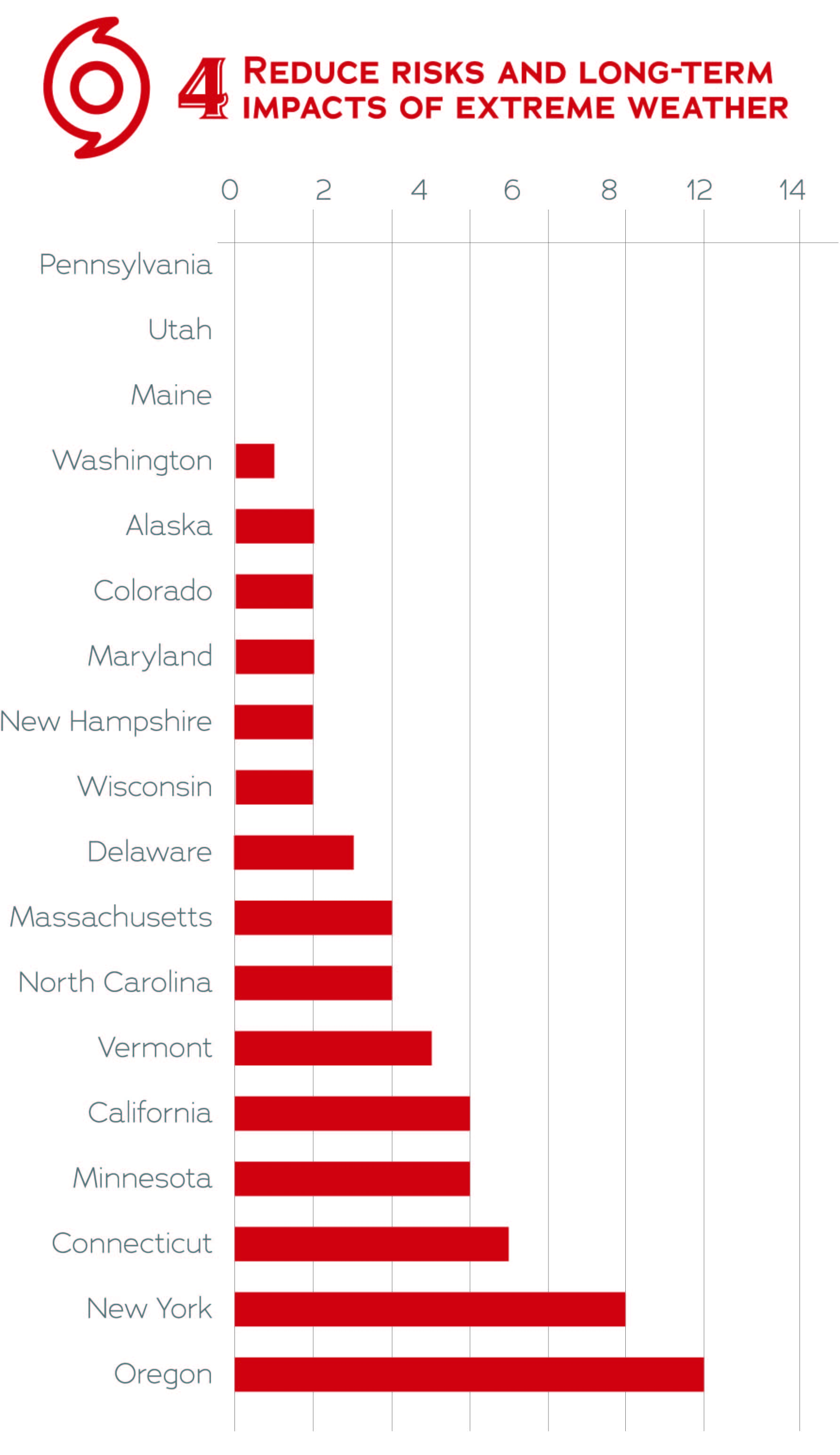
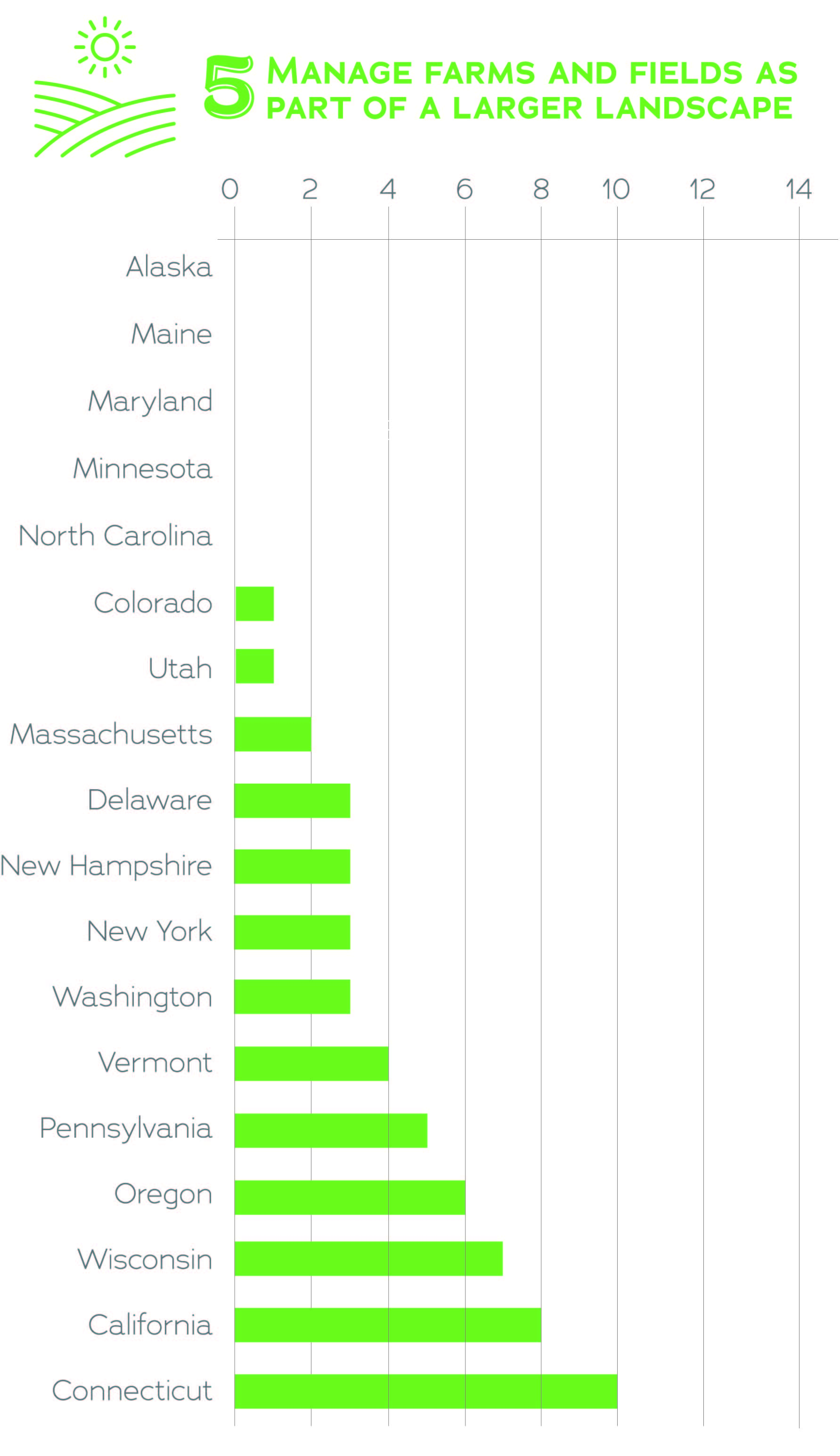
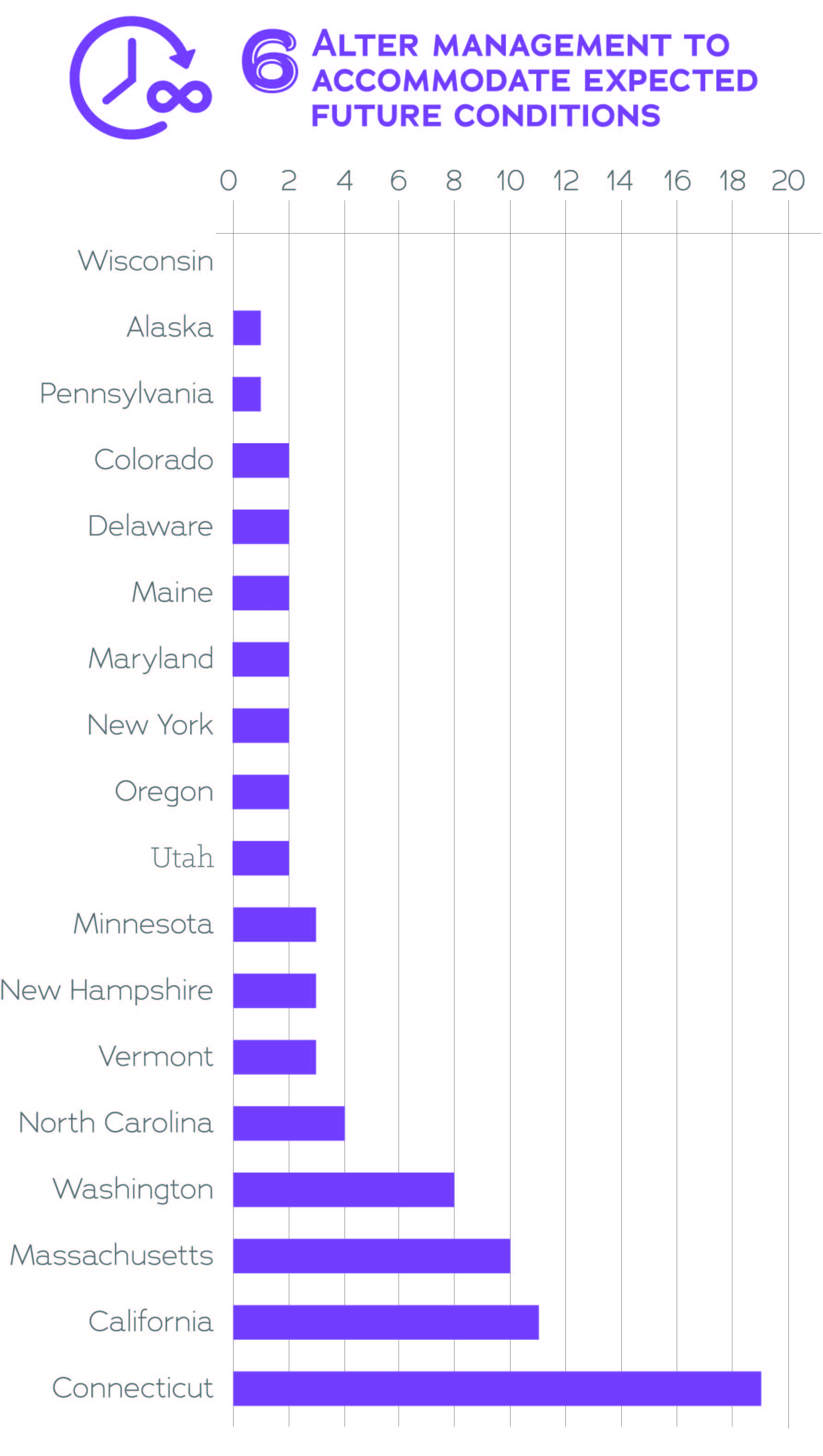
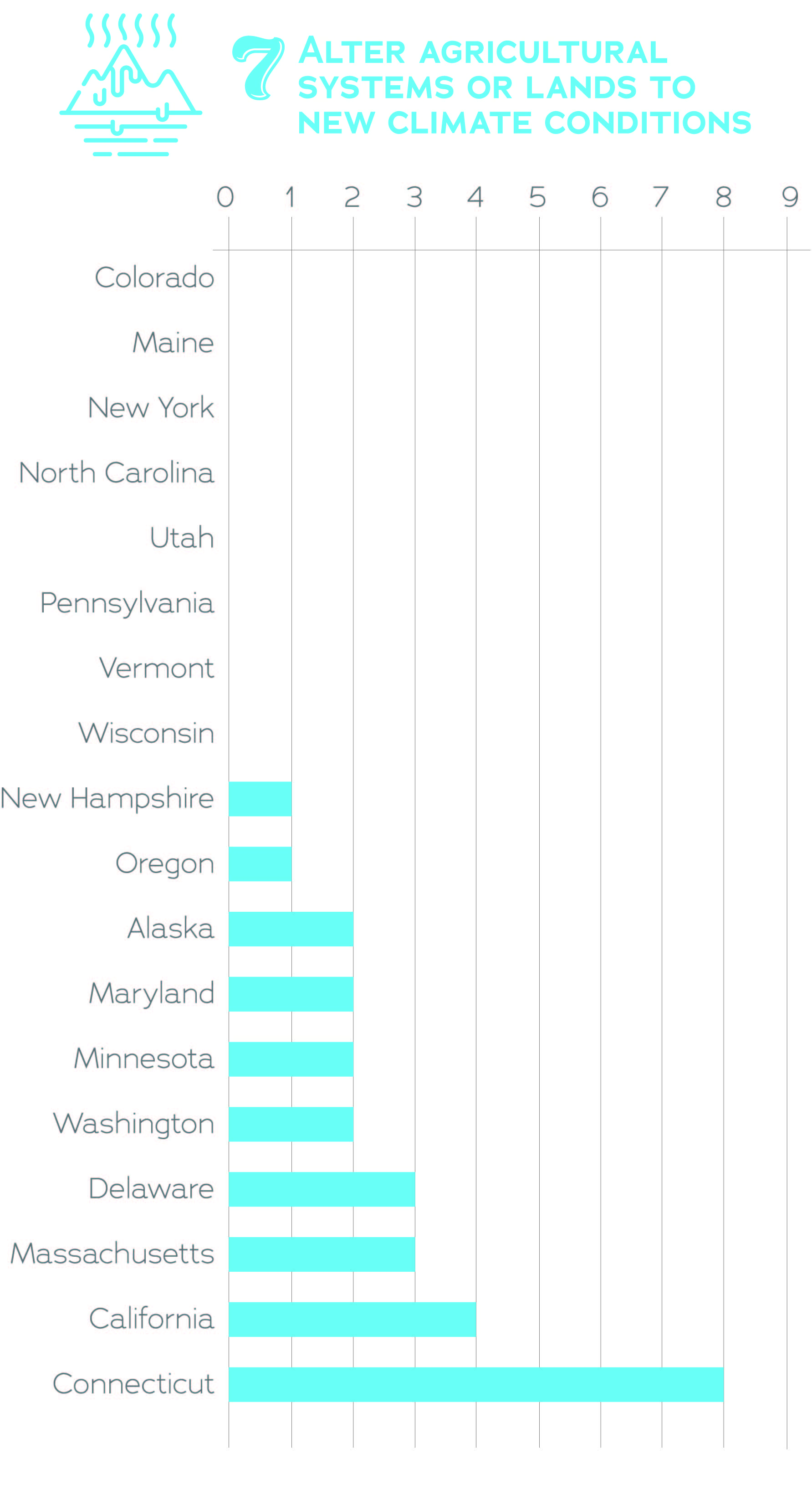
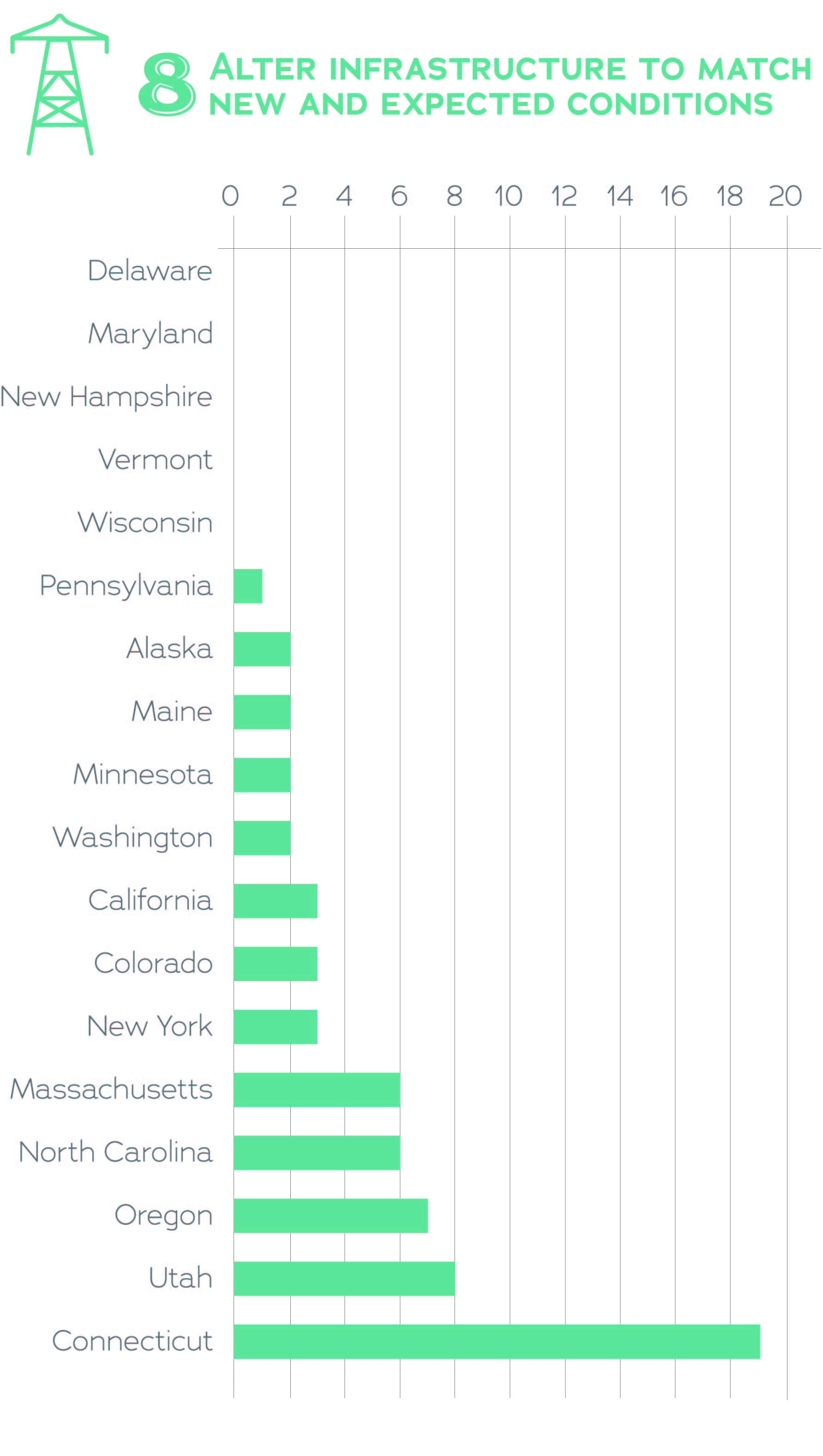
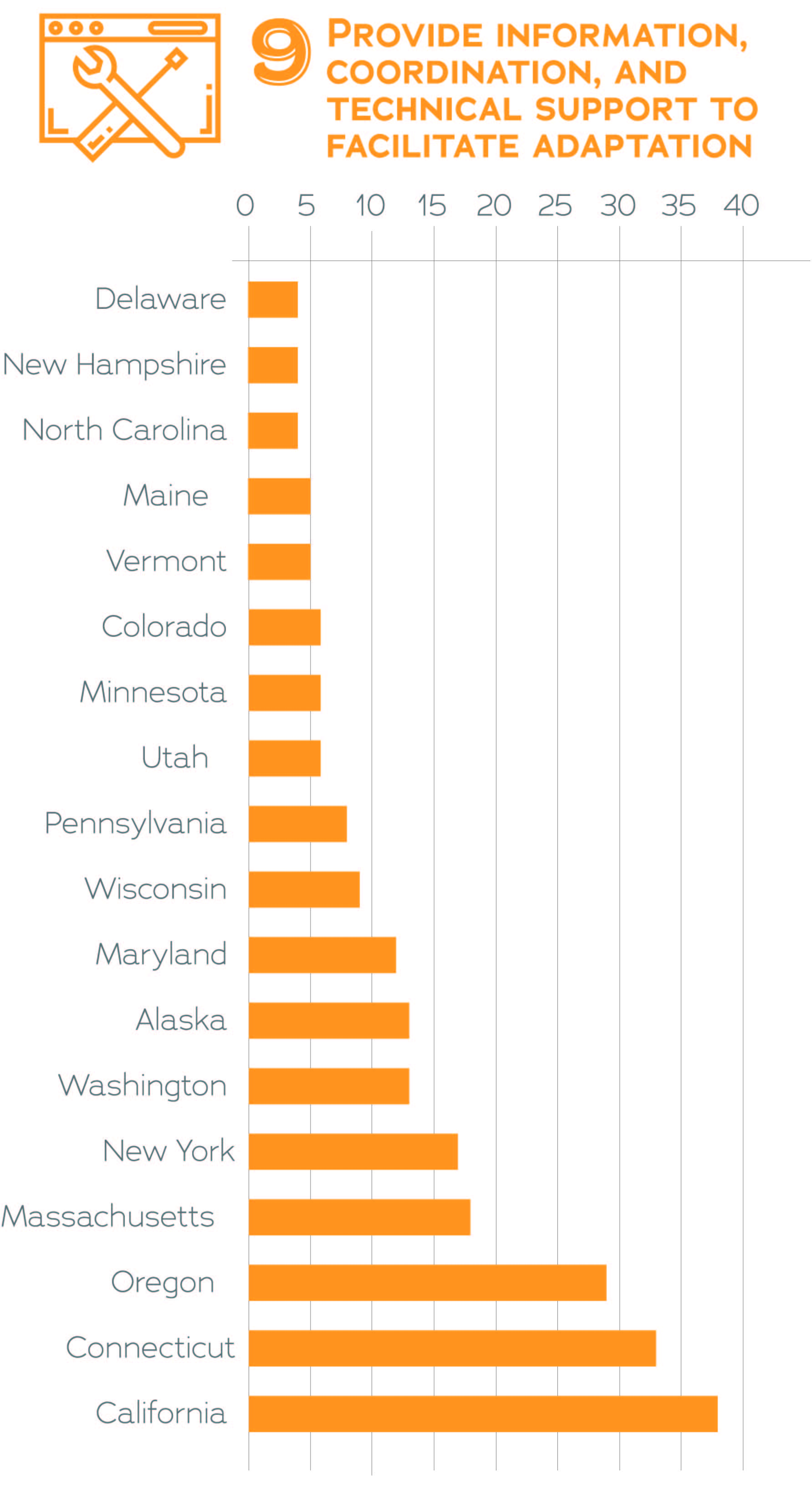
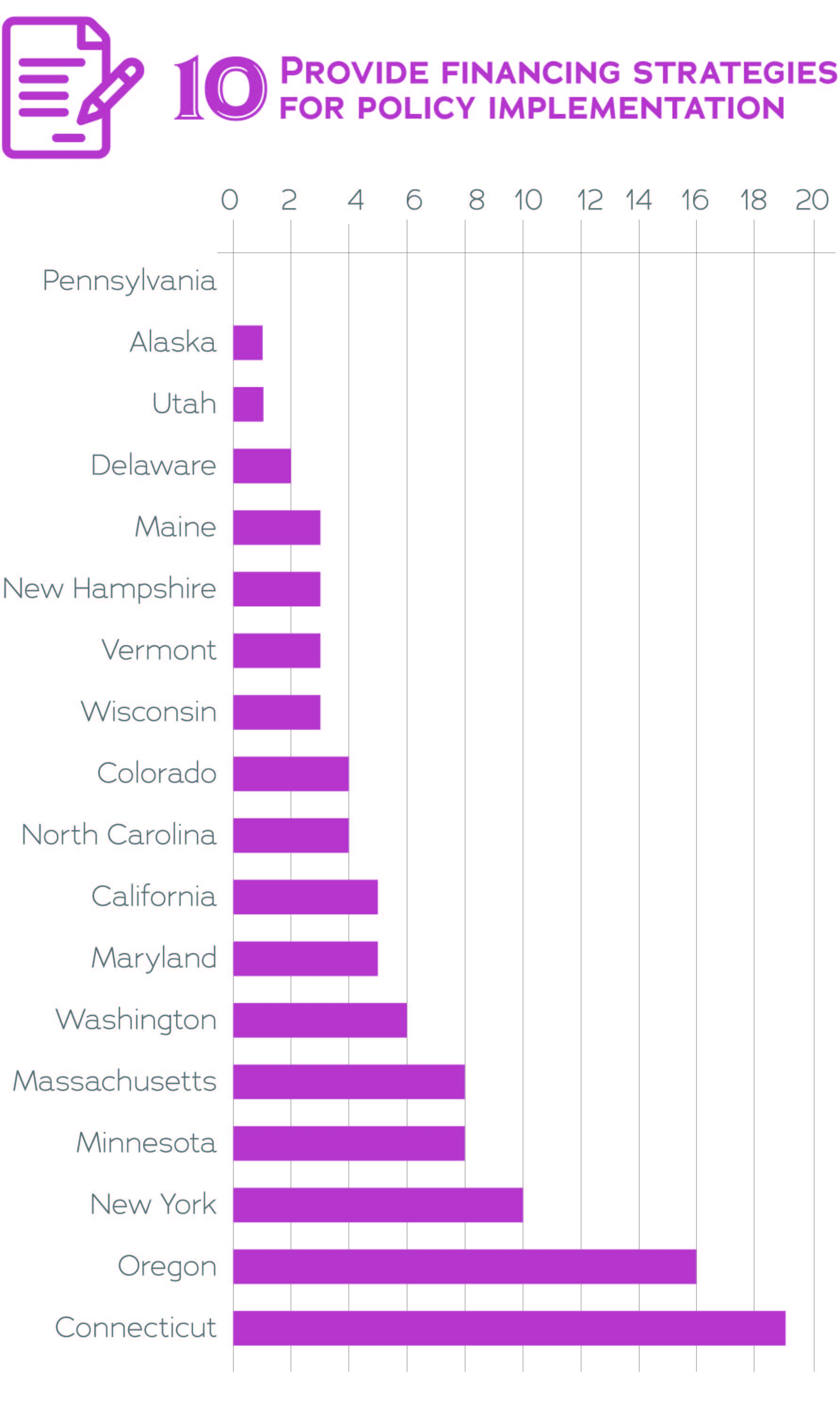
Part 5: State Specific Adaptation Plans
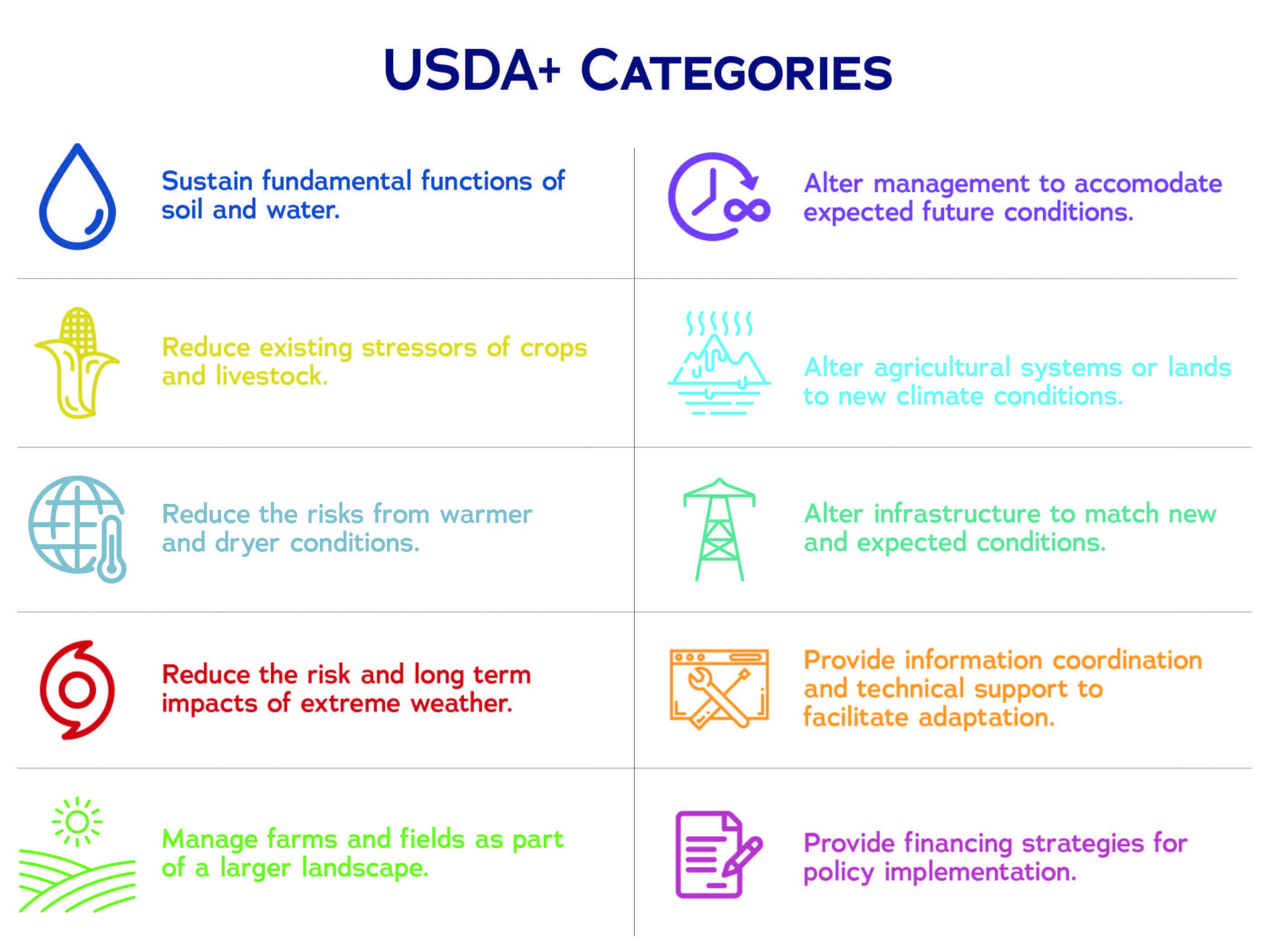
Alaska
Alaska’s Climate Change Strategy: Addressing Impacts in Alaska (2010)36 was produced by the Alaska Adaptation Advisory Group for the Alaska Department of Environmental Conservation. The plan is strong on fisheries management but does not include most other USDA+ categories for climate adaptation. It does give substantial attention to institutional support (9) for the few types of policies proposed, but does not mention drought preparedness (3) or biodiversity (5) and barely covers preparing for extreme weather (4), altering agricultural management and systems to accommodate future climate conditions (6 and 7), infrastructure improvements (8) and financing (10). Pest management (2) receives some attention but not a substantial amount.
Alaska’s Plan Spurring Regional Action
Bryce Wrigley has been a farmer in Delta Junction, Alaska for 35 years. He is President of the Alaska Farm Bureau, District Manager for the Sacha-Delta Soil and Water Conservation District in Delta Junction, and was a reviewer for Alaska’s Climate Adaptation Plan. According to Wrigley, the Alaska plan never got much traction within agencies nor the political support it needed after it was written and consequently has not significantly influenced state policy. However, the plan has been used to guide unofficial adaption planning, and agricultural climate adaptation has progressed at the regional and local levels. An adaptation plan is currently being finalized for the Sacha-Delta Soil and Water Conservation District and will begin its implementation with committee work in the winter of 2017-2018 that builds off some of the principles identified in the state adaptation plan. Some of the goals from that regional plan include: identifying new cropping opportunities that may develop with longer seasons; supporting research into new varieties, soil health, and developing best management practices; enhancing environmental stewardship of farmers to improve soil and water health; and enhancing invasive plant management efforts.37
In October 2017, Alaska Governor Bill Walker created a new Climate Action for Alaska leadership team to draft recommendations for the state by September 2018 in four areas: reducing greenhouse gas emissions, adapting to climate change impacts, research and short-term response.38

California
The proposed policies in Safeguarding California: Reducing Climate Risk (2014)39 by the California Natural Resources Agency makes up a strong plan for agricultural adaptation. The plan is a follow-up to California’s already completed climate adaptation actions identified in 2009. Its main weaknesses are in altering infrastructure (8) to match expected climate conditions, drought preparedness (3) (especially surprising considering the long drought California was experiencing at the time of the report), and altering entire agricultural systems as the climate changes (7), a particular problem for a major agricultural state deeply reliant on an unstable water supply for large monocultural fruit and vegetable farms and mega dairy operations. California’s plan is unique among the states in that it is the second comprehensive adaptation plan in a series. Because of this, it includes sets of policy recommendations that have already been completed and as such were not included in this paper.
Best practice: Biodiversity and Ecosystem services in California
California’s Plan includes a strong set of recommendations for preserving and improving biodiversity:
Implement adaptive management studies to refine approaches for conserving biodiversity, especially for species and communities vulnerable to climate change. …
Create, maintain and support tools that help resource managers determine when and where to focus conservation activities that will protect biodiversity in the face of climate risks. … [and]
Studies of the ability of California’s beneficial species to control new or worsening invasive species problems.
The Current State of California’s Plan
After the 2014 Safeguarding California Plan was published, Governor Jerry Brown signed an executive order40 requiring implementation plans to be created for each sector of adaptation and the state legislature required that an update to the adaptation plan be written every three years by the California Natural Resource Agency. Significant implementation efforts for agriculture are underway and the 2017 update is currently being finalized.41
California’s 2014 plan Safeguarding California: Reducing Climate Risk is an update of an original 2009 plan and includes information on the progress of implementation over those five years. Here is a sample of the programs that have been successfully implemented:42
- The Invasive Species Council of California has created a strategic framework to guide adaptation to invasive species.
- The California Department of Food and Agriculture has, through a USDA Specialty Crop Block Grant Program, funded climate adaptation research on cropping and agricultural management.
- Heat and agricultural worker safety standards have been strengthened.
- Resource Conservation Districts have been set up to control runoff and erosion. Many of them offer mobile irrigation labs to monitor and improve irrigation efficiency and generate awareness of water conservation among the agricultural community.
Progress in implementing the 2014 plan is tracked by updated plans produced every three years. To produce these updates, the agencies assigned to each implementation task submits internal status updates detailing progress that are included in and used to adjust subsequent updates to the plan.43

Colorado
The Colorado Climate Plan (2015)44 by the Colorado Department of Natural Resources includes recommendations for agricultural adaptation that are strong when it comes to maintaining soil and water health (1), and fairly represented on institutional support (9) and financing (10). It contains no policies concerning increasing risks from pests and weeds or for protecting livestock from increasing temperatures (2). Risks from extreme weather (4), preserving biodiversity (5), altering farm management (6) and infrastructure (8) receive only cursory mentions and only as they are related to water quality. Altering agricultural systems (7) receives no attention.
The Current State of Colorado’s Plan
The Colorado Climate Plan (2015) has experienced mixed success in the implementation of its recommendations. Colorado held a “Governor’s Agricultural Forum” in 2017 to engage the public on climate change planning and the Governor has attempted to use his office to support climate action.45 The Colorado Department of Agriculture has primarily focused its climate action on renewable energy and mitigation, though it has undertaken some adaptation efforts focused on water conservation.46
Colorado’s most successful adaptation programs have included information sharing and grants to help producers implement adaptation on their own farms. When provided with information and support, producers have shown themselves very willing to learn and adapt.47
While information sharing and grant programs have been successful, the Colorado Climate Plan has lacked the resources, in staff and funding, to make those programs widespread. Furthermore, while individual producers tend to be open to new adaptation practices, some farm groups are more resistant to change and skeptical of the need for climate adaptation.

Connecticut
The Connecticut Climate Change Preparedness Plan (2011)48 by the Connecticut Department of Energy and Environmental Protection is an impressive, comprehensive set of policy recommendations in every category and in fisheries management. There is still room for improvement, particularly in adapting to pests (2) and extreme weather (4), but even those sections are very solid compared to many other state plans. It also includes some unique policy recommendations covering such issues as supporting young farmers and extending visas to increase the labor supply for longer growing seasons.
Outside the box proposals:
Research how to get more young farmers interested in farming in CT” and “Make more affordable in-state tuition for college agricultural programs.
Best Practice: Infrastructure in Connecticut
Infrastructure improvements are essential to preserving water supply, livestock health, and crop production. Connecticut’s plan includes examples of all three:
Renovate barns for optimal cooling, using non-energy intensive systems (e.g., barns designed to maximize natural ventilation). Renovate or build new dairy barns to maximize passive ventilation and employ active cooling technologies where needed. …
Increase storage of precipitation among all user groups. … [and]
Grow berries in a modified greenhouse approach or high tunnels [and] Use drip irrigation.
Best Practice: Financing Adaptation in Connecticut
Connecticut has a particularly well-rounded set of recommendations for financing adaptation. This is a sample of its policies in several important sectors of financial support.
Renovate or build new dairy barns to maximize passive ventilation and employ active cooling technologies where needed. More money will be needed in grants and education to assist with this. …
Expand federal and state funding of grants for educational and marketing improvements to assist farmers and commodity advocacy organizations. … [and]
Reduce producer risk in the transition to new crops/breeds, infrastructure and production management through: loan guarantees, cost share, farmer research groups, crop insurance and new conservation practices.

Delaware
The Climate Framework for Delaware (2014)49 by the Delaware Department of Natural Resources and Environmental Control has at least one policy recommendation in every category other than infrastructure (8). Most policies are characterized as preliminary recommendations to consider further policy options, for example for water conservation or farm management (1 and 6), educate the public on the negative effects of climate change (9), or preserve habitats (5). It does briefly note necessary fisheries adaptation.

Maine
Maine’s climate adaptation plan, People and Nature: Adapting to a Changing Climate – Charting Maine’s Course (2010)50 by the Maine Department of Environmental Protection provides a considerable number of recommendations for water conservation (1) and pays some attention to institutional support (9) and financing (10). It provides few recommendations for pests and diseases (2), preparing for a warmer climate or extreme weather (3 and 4), biodiversity (5), or altering agricultural systems (7), and only two proposals each for altering farm management (6) and updating infrastructure (8).

Maryland
The Comprehensive Strategy for Reducing Maryland’s Vulnerability to Climate Change – Phase II: Building Societal, Economic, and Ecological Resilience (2010)51 by the Maryland Commission on Climate Adaptation and Response does not devote much space to agriculture. As with many other adaptation plans it does well on institutional support (9) and decently on funding (10) and water conservation (1). Otherwise, its proposals for pests are adequate, and its proposals in every other category are either minimal, as in heat and extreme weather preparedness (3 and 4) and altering agricultural management and systems (6 and 7), or nonexistent, as in the case of biodiversity and infrastructure (5 and 8).

Massachusetts
Massachusetts’ Climate Change Adaptation Report (2011)52 by the Massachusetts Executive Office of Energy and Environmental Affairs and the Adaptation Advisory Committee primarily emphasizes soil and water (1) and institutional support (9). It also offers a robust set of strategies for financing adaptation (10), infrastructure (8), altering farm management (6) and fisheries management. The Massachusetts Adaptation Report’s major gaps are in altering agricultural systems to cope with the new environment (7) and in biodiversity (5).
Outside the box:
Adjust seasonal labor pools. Consider the need to shift from seasonal employment to alternate labor pools should longer warm seasons preclude labor pools dependent on academic calendars or shifting harvest seasons.
Best practice: Massachusetts’ support for small farms
Massachusetts’ plan gives significant attention to helping small farms and building local food systems:
Investigate providing technical and financial support to assist small farms to bring produce to new markets, particularly in urban areas. This may include support for participation in community-supported agriculture by low-income families. …Promote and provide/increase technical and financial support for small-scale farming. … [and]Evaluate the opportunity to provide disaster assistance or insurance for small farms for crop losses.

Minnesota
Adapting to Climate change in Minnesota (2017)53 by the Minnesota Interagency Climate Adaptation Team provides a good set of water conservation policies (1) and, in proportion to its proposals for the other policy categories, an impressive set of financing proposals (10). Sections on pests (2), extreme weather (4) and institutional support (9) are thin. It offers few recommendations for soil health, adapting to warmer temperatures or altering farm management and larger agricultural systems and fails to mention the benefits of biodiversity to agriculture.
Outside the box:
Food Safety Rapid Response Team: Consisting of technical experts in food manufacturing, food inspection, microbiology and epidemiology, this team can verify the safety of stored food products after a disaster.
The Current State of Minnesota’s Plan
Adapting to Climate Change in Minnesota was only recently published in May 2017 but plans are already underway to begin implementation. These plans include an implementation working group established in each of the six categories for implementation used in the 2017 plan, which include:
- building greater resilience to extreme precipitation;
- supporting the health of vulnerable populations through state and local government cooperation;
- focusing on preserving terrestrial and aquatic habitat to increase reliance of wildlife and native plants;
- strengthening agricultural water management efforts to increase resilience to climate change impacts;
- increasing focus on managing climate impacts in cities, towns and other population centers; and
- and strengthening climate information infrastructure to support adaptation practices.54

New Hampshire
The New Hampshire Climate Action Plan (2009)55 by the New Hampshire Department of Environmental Services Climate Change Policy Task Force provides a few recommendations each for financing (10), improving biodiversity (5) and altering farm management to accommodate expected climate changes (6). Its recommendations for informational and technical support (9) are thin compared to most other state plans; it has little to say about water conservation (1) and preparation for extreme weather, and says little on soil health (1), pests and diseases (2), altering agricultural systems (7) and infrastructure improvements (8).
Outside the box:
The New Hampshire plan uniquely contains several proposals about limiting urban sprawl to preserve agricultural land.

New York
The New York State Climate Action Council Interim Report—Adaptation Technical Work Group Recommendations (2010)56 is impressively strong in some categories. It contains comprehensive sets of recommendations for adaptation to new pests and diseases (2), adaptation to increasing temperatures and more prevalent extreme weather (3 and 4), institutional support (9) and funding (10). It has little to say about soil and water conservation (1), adaptive farm management (6) or altering agricultural systems (7) and completely neglects infrastructure (8).
Outside the box:
Ensure equity is incorporated into programs targeting agricultural adaptation

North Carolina
Climate Ready North Carolina: Building a Resilient Future (2012)57 by the North Carolina Interagency Leadership Team provides adequate recommendations in a few categories, most notably infrastructure (8) but also to a lesser extent funding (10), extreme weather (4) and farm management (6). Otherwise it makes only a few recommendations each for soil and water conservation (1) and increasing temperatures (3), while pests (2) are only mentioned briefly. Biodiversity (5) and altering agricultural systems (7) are not mentioned at all and institutional support (9) received far less attention than in almost any other state plan.

Oregon
The Oregon Climate Change Adaptation Framework (2010)58 by the Oregon Climate Change Research Institute makes an impressive total number of policy recommendations. Sections on pests (2), technical support (9) and financing adaptation (10) are comprehensive. The report makes exhaustive recommendations for water conservation, but pays less attention to soil conservation (1) and similarly recommends plenty of adaptation strategies for extreme weather (4) but little for increasing temperatures (3). The related topics of altering farm management (6) and agricultural systems (7) to changing climate conditions receive only cursory mentions. Outside of our categories, fisheries management receives some attention, and the report uniquely suggests that Oregon collaborate with the Centers for Disease Control and Prevention to prevent the spread of non-native pests and diseases.
Outside the box:
Lead a statewide summit on invasive species and co-host, with Washington, Idaho, and California, a regional summit on invasive species. … Develop policies that help limit development and post-disaster reconstruction in hazard-prone areas.
Best practice: Staff Support in Oregon
Oregon’s Plan uniquely suggests increases in staff support. An important aspect of institutional support only mentioned once (by New Hampshire) in any of the other plans; but, as noted in the Colorado Case Study, is incredibly important to implementation. These recommendations come in the form of independent calls for staff, such as:
Add technical assistance program staff. … [and]
Establish a tax credit program for projects that save at least 10 percent of the water used in an industrial, agricultural, or commercial process, and provide staff to manage the program.”

Pennsylvania
The Pennsylvania Climate Adaptation Planning Report: Risks and Practical Recommendations (2014)59 by the Pennsylvania Department of Environmental Protection provides policy recommendations for a few categories: soil and water conservation (1), pests (2), biodiversity (5) and institutional support. It includes only one recommendation each in the infrastructure (6) and improved farm management (6) categories and does not mention funding (10), warmer and dryer conditions (3), extreme weather (4) or altering agricultural systems (7). Additionally, three suggestions are made for protecting fisheries.

Utah
Drought in Utah: Learning from the Past, Preparing for the Future (2007)60 by the Utah Division of Water Resources is unique among state adaptation plans in that it actively presents itself as a drought plan. As expected, the plan proposes a strong set of policies for water conservation (1), adaptation to increased temperatures (3) and water related infrastructure (8). Those policies are bolstered by some institutional support (9). Financing adaptation (10), biodiversity (5) and improved farm management (10) receive only token mentions. Pests (2) and altering agricultural systems (7) are not included.
Outside the box:
The plan includes unique suggestions to prepare for drought such as connections between water banks to distribute load and other methods of increasing cooperation and water distribution.

Vermont
Vermont’s Climate Change Adaptation Framework (2013)61 does not include substantial recommendations for agriculture, but the state had previously produced an agriculture-focused adaptation document: The Potential Impacts of Climate Change on Agriculture in Vermont (2010). The 2010 report is unique among state adaptation plans in that it is focused entirely on adaptation for agriculture, rather than climate adaptation generally. It provides some recommendations for adapting to warmer and extreme weather (3 and 4) and biodiversity (5) and offers possible policies in every other category with the exception of policies to alter agricultural systems and upgrade infrastructure. Outside of these categories it does make some noteworthy proposals to support family farms and local food systems as adaptation strategies.

Washington
Preparing for a Changing Climate: Washington State’s Integrated Climate Response Strategy (2012)62 by the Washington State Department of Ecology makes recommendations in every category. It is strong on soil and water conservation (1), pests (2), improved farm management (6) and technical support (9) and additionally provides at least a set of recommendations for funding (10) and adaptation to warmer weather (3). This is contrasted by only light attention to extreme weather (4), biodiversity (5), altering farm systems (7) and infrastructure (8). The Plan also notes the importance of local food and preventing the conversion of agricultural lands to urban development.

Wisconsin
Wisconsin’s Changing Climate: Impacts and Adaptation (2011)63 by the Wisconsin Initiative on Climate Change Impacts has a huge variance in its attention to adaptation in each category. Soil and water conservation (1) is covered in detail, while adapting to warmer weather, altering farm management (6), altering agricultural systems (7) and improving infrastructure (8) are not mentioned at all. Technical support (9) and biodiversity (5) receive a solid amount of attention, while pests (2), extreme weather (4) and funding (10) are barely noted. The Plan also includes recommendations for preserving fisheries including very specific recommendations for different fisheries around the state.
Outside the box:
Build a stronger relationship with the public to establish a critical mass of ecological knowledge in the community. Assemble oral histories photos, records, and studios to document previous conditions and present them to the public.

Endnotes
- National Oceanic and Atmospheric Administration. Billion-Dollar Weather and Climate Disasters: Overview. Accessed October 26, 2017. https://www.ncdc.noaa.gov/billions/
- U.S. Department of agriculture, (2016), “Adaptation Resource for Agriculture: Responding to Climate Variability and Change in the Midwest and Northeast,” available at https://www.climatehubs.oce.usda.gov/sites/default/files/adaptation_resources_workbook_ne_mw.pdf
- Christopher Collins. “New Estimate Puts Harvey’s Agriculture Losses at $200 million, One-Tenth of Irma.” Texas Observer. October 27, 2017. https://www.texasobserver.org/agriculture-losses-estimated-200-million-harvey/
- Georgina Gustin. “Hurricane Harvey Batters Texas Farms, Stranding Cattle and Destroying Crops.” Inside Climate News. September 2, 2017. https://insideclimatenews.org/news/02092017/hurricane-harvey-texas-farms-climate-change-cotton-cattle-longhorns-ranches-photos
- Kate Yoder. “Hurricane Irma Wiped Out Half of Florida’s Citrus Crop.” Grist. September 14, 2017. http://grist.org/briefly/hurricane-irma-wiped-out-half-of-floridas-citrus-crop/
- Krissa Welshans. “Ag Losses from Irma Estimated at Over $2.5 billion.” Feedstuffs. October 12, 2017. http://www.feedstuffs.com/news/ag-losses-irma-estimated-over-25b
- Ashwini Sankar. “The Worst They’ve Ever Seen.” Fedgazette. Federal Reserve Bank of Minneapolis. November 8, 2017. https://minneapolisfed.org/publications/fedgazette/the-worst-theyve-ever-seen
- Nate Hegyi. “Sudden Droughts and Wildfires are a Vision of Montana’s Future, says State Climatologist. Montana Public Radio. August 22, 2017. http://mtpr.org/post/sudden-droughts-and-wildfires-are-vision-montanas-future-says-state-climatologist
- Marc Heller. “Something Isn’t Right in Montana Wheat Fields.” E & E News. July 5, 2017. https://www.eenews.net/stories/1060056894
- James Pelz. “Warning to Avocado Lovers: a California Shortfall May Send Prices Soaring.” Los Angeles Times. August 15, 2017. http://www.latimes.com/business/la-fi-avocado-prices-20170815-story.html
- Associated Press. “Thousands of Cows Die in California Heat Wave; Disposing Them Becomes a Problem.” July 8, 2017. http://www.latimes.com/local/lanow/la-me-cattle-deaths-20170708-story.html
- Russ Quinn. “Rising From the Ashes, Hope Continues to Burn Bright for Southern Plains Ranchers.” DTN. June 6, 2017. https://www.dtnpf.com/agriculture/web/ag/news/article/2017/06/01/congressmen-want-know-justice-keeps
- Dan Elliott. “High Plains Farm Trouble.” Associated Press. http://www.chicagotribune.com/news/nationworld/sns-bc-us--high-plains-farm-trouble-20170426-story.html
- Drovers. “Feedyards Scramble to Recover from Blizzard.” May 1, 2017. http://www.cattlenetwork.com/news/industry/feedyards-scramble-recover-blizzard
- Isabella Moller. “U.S. Secretary of Agriculture Sees Flood Damage, Estimates 940,000 Acres Destroyed.” Arkansas Matters. May 7, 2017. http://www.arkansasmatters.com/news/local-news/us-secretary-of-agriculture-sees-flood-damage-estimates-940000-acres-destroyed/708944876
- U.S. Global Climate Change Program. National Climate Assessment. 2014. http://nca2014.globalchange.gov/report/our-changing-climate/future-climate-change
- National Oceanic and Atmospheric Administration. Billion-Dollar Weather and Climate Disasters: Overview. Accessed October 26, 2017. https://www.ncdc.noaa.gov/billions/
- U.S. Department of Agriculture Midwest, Northeast, and Northern Forest Climate Hubs. Adaptation Resources for Agriculture: Responding to Climate Variability and Change in the Midwest and Northeast. October 2016. https://www.climatehubs.oce.usda.gov/sites/default/files/adaptation_resources_workbook_ne_mw.pdf
- Ceres. Feeding Ourselves Thirsty. Accessed October 26, 2017. https://feedingourselvesthirsty.ceres.org/
- Risky Business Project. National Report: The Economic Risks of Climate Change in the U.S. June 24, 2014. https://riskybusiness.org/report/national/
- UN Food and Agriculture Organization. Tracking Adaptation in Agricultural Sectors. 2017. http://www.fao.org/3/a-i8145e.pdf
- Intergovernmental Panel on Climate Change. Climate Change 2014: Impacts, Adaptation and Vulnerability. 2014. http://www.ipcc.ch/report/ar5/wg2/
- National Sustainable Agriculture Coalition. “Farmers Continue to Reap Big Benefits from Cover Crops.” September 22, 2017. http://sustainableagriculture.net/blog/cover-crop-survey-2017/
- Heather Haddon. “Farmers Scramble to Adapt to Volatile Weather.” May 14, 2017. Wall Street Journal. https://www.wsj.com/articles/farmers-scramble-to-adapt-to-volatile-weather-1494813840
- Georgina Gustin. “Spongy Soil Can Help Farmers Combat Climate Change.” Inside Climate News. August 9, 2017. https://insideclimatenews.org/news/08092017/climate-change-agriculture-farm-soil-soybeans-cover-crop-water-drought
- Brian J. Wienhold, Merle F. Vigil, John R. Hendrickson, Justin D. Derner. “Vulnerability of crops and croplands in the US Northern Plains to predicted climate change.” Climate Change. May 23, 2017.
- https://link.springer.com/article/10.1007/s10584-017-1989-x
- National Adaptation Forum. https://www.nationaladaptationforum.org/
- Institute for Agriculture and Trade Policy. Rural Climate Dialogues. http://ruralclimatenetwork.org/content/rural-climate-dialogues
- Diana Donlan. “6 States Tapping the Benefits of Carbon Farming.” July 12, 2017. Ecowatch. https://www.ecowatch.com/carbon-farming-2457937143.html
- California Department of Food and Agriculture. “CDFA Announces Grant Funding Available for Healthy Soils Program in 2017.” August 8, 2017. https://www.cdfa.ca.gov/egov/Press_Releases/Press_Release.asp?PRnum=17-044
- Ingfei Chen. “How Heat Kills Farmworkers.” Mother Jones. September 20, 2017. http://www.motherjones.com/food/2017/09/farmworkers-hot-days-deadly-mendota-california/#
- State Assemblywoman Didi Barrett. State Budget Invests in Hudson Valley Farmers. August 12, 2017. http://nyassembly.gov/mem/Didi-Barrett/story/74335/
- U.S. Department of agriculture, (2016), “Adaptation Resource for Agriculture: Responding to Climate Variability and Change in the Midwest and Northeast,” available at https://www.climatehubs.oce.usda.gov/sites/default/files/adaptation_resources_workbook_ne_mw.pdf
- Brad Plumer and Nadja Popovich, “As Climate Changes, Southern States Will Suffer More Than Others,” the New York Times, June 29, 2017. Available at https://www.nytimes.com/interactive/2017/06/29/climate/southern-states-worse-climate-effects.html?_r=0
- Adaptation Advisory Group to the Alaska Climate Change Sub-Cabinet, (2010), “Alaska’s Climate Change Strategy: Addressing Impacts in Alaska, ” available at http://climatechange.alaska.gov/aag/docs/aag_all_rpt_27jan10.pdf
- Everything in this section is from our email correspondence
- Nathaniel Herz. “Gov. Walker Creates Climate Change Committee, But Leaves Decisions for Later.” Alaska Dispatch News. October 31, 2017. https://www.adn.com/politics/2017/10/31/gov-walker-creates-climate-change-committee-but-leaves-decisions-for-later/
- California Natural Resources Agency, (2014), p. 28 – 34. Available at “Safeguarding California: reducing Climate Risk,” available at http://resources.ca.gov/docs/climate/Final_Safeguarding_CA_Plan_July_31_2014.pdf
- Brown Jr., Edmund G. (April 29, 2015). California Executive Order B-30-15, available at https://www.gov.ca.gov/news.php?id=18938
- This paragraph is from our email correspondence with joseph wall from the California DNR
- California Natural Resources Agency, (2014), “Safeguarding California: reducing Climate Risk,” available at http://resources.ca.gov/docs/climate/Final_Safeguarding_CA_Plan_July_31_2014.pdf
- This paragraph is also from our email correspondence
- Colorado Department of Natural Resources, (2015), “Colorado Climate Plan,” available at http://cwcbweblink.state.co.us/WebLink/ElectronicFile.aspx?docid=196541&searchid=243b8969-739b-448c-bd2d-699af9b7aea0&&dbid=0
- From phone conversation with Taryn Finnessey, Senior Climate Change Specialist at the Colorado Department of Natural Resources
- Colorado Water Conservation Board, (2017), “2017 Legislative Climate Update,” available at http://cwcb.state.co.us/environment/climate-change/Documents/2017_AnnualClimateUpdate.pdf
- Last two paragraphs from phone conversation with Taryn
- Connecticut Department of Energy and Environmental Protection, (2011), “Connecticut Climate Change Preparedness Plan,” available at http://www.ct.gov/deep/lib/deep/climatechange/connecticut_climate_preparedness_plan_2011.pdf
- Delaware Department of Natural Resources and Environmental Control, (2014), “Climate framework for Delaware,” available at http://www.dnrec.delaware.gov/energy/Documents/The%20Climate%20Framework%20for%20Delaware%20PDF.pdf
- Maine Department of Environmental Protection, (2014), “ People and Nature: Adapting to a Changing Climate – Charting Maine’s Course,” available at http://www.maine.gov/dep/sustainability/climate/preparation-adaptation.html
- Maryland Commission on Climate Change Adaptation and Response and Scientific and Technical Working Groups, (2010), “The Comprehensive Strategy for Reducing Maryland’s Vulnerability to Climate Change – Phase II: Building Societal, Economic, and Ecological Resilience,” available at http://mde.maryland.gov/programs/Marylander/Documents/MCCC/Publications/Adaptation/ian_report_2991.pdf
- Massachusetts Executive Office of Energy and Environmental Affairs and the Adaptation Advisory Committee, (2011), “Massachusetts Climate change Adaptation Report,” available at http://www.mass.gov/eea/docs/eea/energy/cca/eea-climate-adaptation-report.pdf
- Minnesota Interagency Climate Adaptation Team, (2017), “Adapting to Climate Change in Minnesota,” available at https://www.pca.state.mn.us/sites/default/files/p-gen4-07c.pdf
- From Paul Moss speaking at the EQB meeting
- New Hampshire Department of Environmental Services Climate Change Policy Task Force, (2009), “The New Hampshire Climate Action Plan,” available at https://www.des.nh.gov/organization/divisions/air/tsb/tps/climate/action_plan/documents/nhcap_final.pdf
- New York State Climate Action Council, (2010), “New York State Climate Action Council Interim Report -- Adaptation Technical Work Group Recommendations,” available at http://www.dec.ny.gov/docs/administration_pdf/twgadaptrec.pdf
- North Carolina Interagency Leadership Team, (2012), “Climate Ready North Carolina: Building a Resilient Future,” available at http://www.climatechange.nc.gov/Climate_Ready_North_Carolina_Building_a_Resilient_Future.pdf
- Oregon Climate Change Research Institute, (2010), “The Oregon Climate Change Adaptation Framework,” available at http://www.oregon.gov/LCD/docs/ClimateChange/Framework_Final.pdf
- Pennsylvania Department of Environmental Protection, (2014), “Pennsylvania Climate Adaptation Planning Report: Risks and Practical Recommendations,” available at http://www.elibrary.dep.state.pa.us/dsweb/Get/Document-103584/2700-RE-DEP4303%20Combined.pdf
- Utah Division of Water Resources, (2007), “Drought in Utah: Learning from the Past - Preparing for the Future,” available at https://collections.lib.utah.edu/details?id=1158978
- Dunnington, Gwen, (2010), “The Potential Impacts of Climate Change on Agriculture in Vermont,” available at http://anr.vermont.gov/sites/anr/files/specialtopics/climate/documents/VTCCwhitepapers/VTCCAdaptAgriculture.pdf
- Washington State Department of Ecology, (2012), “Preparing for a Changing Climate: Washington State’s Integrated Climate Response Strategy,” available at https://fortress.wa.gov/ecy/publications/documents/1201004.pdf
- Wisconsin Initiative on Climate Change Impacts, (2011), “Wisconsin's Changing Climate: Impacts and Adaptation,” available at http://www.wicci.wisc.edu/report/2011_WICCI-Report.pdf